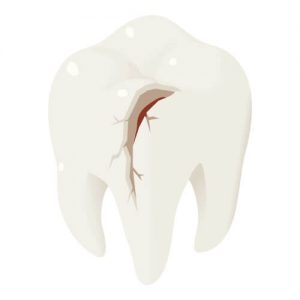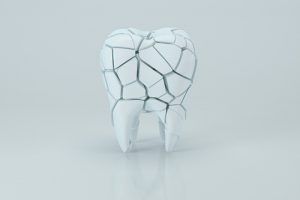
Hairline Cracks in Teeth Treatment: 8 Successful Treatment Options
Navigating the intricate world of dental health can be daunting, especially when confronted with nuanced issues like hairline cracks in teeth. Knowing hairline cracks in teeth treatment is important for maintaining a beautiful smile and ensuring overall oral health. Untreated cracks can lead to more severe dental issues, increased sensitivity, and potential infections.
What causes these minute fractures? How do they impact our overall dental health? And most importantly, how can they be effectively treated? Join us as we embark on a journey to demystify this topic, offering insights that could be pivotal for your oral well-being.
How does hairline fracture look like
Hairline fractures, though subtle, are a topic of concern in both medical and dental fields. Their nuanced appearance can sometimes make them challenging to identify, especially for the untrained eye. Delving into how these fractures present themselves can provide clarity and aid early detection.
- Subtlety in Presentation: Hairline fractures are aptly named for their fine, thread-like appearance. Unlike more pronounced fractures, they don’t always manifest as clear breaks or bone or tooth structure separations. Instead, they might appear as thin, almost invisible lines.
- Surface Visibility: On teeth, hairline fractures can sometimes be seen on the enamel’s surface. They might be more noticeable on the chewing surface or near the gum line. However, they can also be beneath the surface, making them easier to detect with specialized equipment.
- Depth and Extension: While they start as superficial cracks, hairline fractures can sometimes extend deeper into the structure they affect. In teeth, for instance, they might progress from the enamel to the dentin or even reach the pulp in severe cases.
- Associated Symptoms: While the visual identification of a hairline fracture is essential, they might also present other symptoms. In the context of teeth, there might be increased sensitivity to temperature changes or discomfort while chewing.
- Comparison with Other Lines: Different hairline fractures from other lines that might appear on structures is crucial. For example, in teeth, craze lines are superficial cracks in the enamel that don’t threaten the tooth’s integrity. They can look similar to hairline fractures but are generally more benign.
While hairline fractures are subtle and can sometimes be overlooked, understanding their appearance and associated symptoms is crucial. Early detection and intervention can prevent potential complications and ensure the health and integrity of the affected structure.
Types of hairline cracks in teeth
While remarkably resilient, the intricate structure of our teeth is not immune to the wear and tear of daily life. One manifestation of this wear is the development of hairline cracks in teeth. Though often subtle, these cracks can vary in type and severity, each with its unique implications for dental health. To better understand the nuances of these hairline fractures, it’s essential to delve into the types of vertical cracks that can occur.
- Craze Lines: These are tiny, superficial cracks that only affect the tooth’s outer enamel. They are often cosmetic and don’t typically cause pain or require treatment. Their appearance is akin to fine lines on the surface of the tooth.
- Fractured Cusp: This type of crack often occurs around dental fillings. It doesn’t usually affect the tooth’s pulp and might not cause much pain. However, if left untreated, the cusp may break off.
- Cracked Tooth: This crack starts from the chewing surface and extends downwards but doesn’t yet reach the gum line. It can cause pain, especially when chewing, as the pressure can cause the crack to spread. Root canal therapy or dental crowns might be necessary treatments.
- Split Tooth: This crack has progressed from the tooth’s surface and has split the tooth into two distinct segments. It’s often the result of an untreated cracked tooth. In most cases, the affected portion of the tooth needs to be removed.
- Vertical Root Fracture: Starting from the root and moving upwards, this type of crack is often the most challenging to detect since it doesn’t show many symptoms until the surrounding bone and gum become infected.
- Hairline Tooth Fracture: This is a fine crack, similar to craze lines, but it can extend deeper into the tooth structure, potentially reaching the dentin or even the pulp. Depending on its severity, it might require more intensive treatments like root canal therapy or dental bonding.
In conclusion, while hairline cracks in teeth might sound straightforward, it encompasses a range of fractures, each with its characteristics and implications for fractured teeth. Recognizing the differences can aid in early detection and appropriate treatment, ensuring the longevity and health of our teeth.
Causes of hairline cracks in teeth
The integrity of our teeth is paramount to our overall oral health. However, various factors can compromise this integrity over time, leading to hairline cracks in teeth. While often subtle, these cracks can be a precursor to more significant dental issues if not addressed promptly. To better understand the root causes of these hairline crack fractures, exploring the various factors contributing to their development is essential.
- Teeth Grinding: One of the most common culprits behind hairline cracks is chronic teeth grinding, often occurring unconsciously during your sleep. This repetitive force and pressure can lead to craze lines and more pronounced tooth cracks over time.
- Chewing Hard Objects: Habitually chewing on hard objects like ice, hard candy, or even non-food items can exert undue pressure on the teeth, leading to cracks.
- Dental Procedures: Some dental procedures, like the placement of dental crowns or extensive root canal treatment, can inadvertently introduce stress to the tooth structure, increasing the risk of cracks.
- Natural Aging: As teeth age, they naturally undergo wear and tear. This can manifest as craze lines or more pronounced hairline tooth fractures.
- Trauma: Accidental trauma, like a blow to the mouth or biting down suddenly on a hard object, can result in a cracked tooth or even a split tooth.
- Temperature Extremes: Constant exposure to extreme temperature changes, such as consuming very hot food followed by an icy drink, can cause the tooth enamel to expand and contract, leading to hairline cracks.
- Structural Weakness: Teeth that have undergone extensive dental work or have large fillings might be structurally weakened, making them more susceptible to fractures, including vertical root fractures.
In conclusion, hairline cracks in teeth can arise from myriad causes, ranging from habitual behaviors to accidental traumas. Recognizing these causes and taking preventive measures can go a long way in preserving the health and longevity of our teeth.
The most common symptoms of cracked tooth
A cracked tooth, while seemingly innocuous, can be a significant source of discomfort and can lead to more severe dental complications if left untreated. Recognizing the symptoms early on is crucial for timely intervention and to prevent further damage. While the manifestations can vary depending on the severity and location of the tooth crack itself, certain symptoms are commonly associated with a cracked tooth.
- Pain on Chewing: One of the most telltale signs of a cracked tooth is a sharp pain when biting down or chewing. This pain might be intermittent, making it sometimes challenging to pinpoint.
- Sensitivity to Temperature: A cracked tooth often becomes highly sensitive to hot or cold foods and beverages. This sensitivity can manifest as a sudden, sharp pain when the tooth is exposed to temperature extremes.
- Swollen Gums: Sometimes, the gum tissue surrounding the cracked tooth may become inflamed or swollen, indicating an underlying issue.
- Discoloration: A tooth that has cracked might show signs of discoloration, often turning a grayish or yellowish hue, different from the surrounding teeth.
- Visible Lines: For some individuals, the crack might be visible to the naked eye, appearing as a thin line on the tooth’s surface.
- Localized Discomfort: A persistent, localized discomfort or a dull ache around the affected tooth can indicate a crack, especially if there’s no evident cause for the pain.
In summary, while a cracked tooth can present in various ways, being vigilant about these common symptoms can aid in early detection and treatment. Regular dental check-ups and seeking professional advice when these symptoms arise can ensure the health and longevity of one’s teeth.
How to treat hairline fractures in teeth successfully
Hairline fractures in teeth, though subtle, can pose significant dental challenges if not addressed promptly. These tiny fractures can be caused by various factors, from biting hard objects to jaw clenching. Successfully treating them requires a comprehensive approach tailored to the specific nature and severity of the crack. Here’s a detailed guide on how to effectively address hairline fractures in teeth:
- Early Detection: Regular visits to the dentist can help in the early detection of hairline fractures. You must see your dentist immediately if you experience sharp pain, especially when exposed to hot or cold temperatures.
- Dental Bonding: Dental bonding can be an effective treatment for superficial cracks that haven’t compromised the tooth’s structure. This procedure involves applying a tooth-colored resin to the affected tooth, which is then hardened using a special light.
- Dental Crowns: A dental crown might be recommended for more pronounced fractures or those that have resulted in significant tooth decay. This acts as a protective cap, preserving the damaged tooth and restoring its function.
- Root Canal Therapy: If the crack extends deep into the tooth, affecting the blood vessels and nerves, this case may require root canal therapy. This procedure involves removing the damaged pulp, cleaning the tooth’s inner chamber, and sealing it.
- Tooth Extraction: In severe cases where the fracture has compromised the entire tooth, extraction might be the only viable option. Dental implants or bridges would follow this to replace the extracted tooth.
- Maintaining Oral Health: Practicing good oral hygiene is pivotal. Regular brushing, flossing, and avoiding hard objects prevent further damage and keep teeth healthy.
- Avoiding Potential Causes: Being mindful of habits like jaw clenching, biting on hard objects, or having large fillings can reduce the risk of developing hairline fractures.
- Regular Dental Check-ups: Regularly seeing a dentist ensures that any dental issue, including hairline fractures, is detected and treated early, preventing more severe dental issues down the line.
In conclusion, while hairline fractures in teeth can be concerning, a combination of early detection, appropriate treatment options, and good oral health can ensure successful management and prevention of further complications.
How to fix a cracked tooth naturally at home
A cracked tooth, while a common dental issue, can be a source of discomfort and concern. While it’s essential to consult with a dentist for a definitive solution, natural remedies can be employed at home to alleviate pain and prevent further damage to broken teeth. Here’s a guide on how to address a cracked tooth naturally:
- Saltwater Rinse: Gargling with warm salt water can help reduce inflammation and pain. The salt acts as a natural disinfectant, helping to keep the area clean and free from harmful bacteria.
- Cold Compress: Applying a cold compress or ice pack wrapped in a cloth to the affected area can help reduce swelling and numb the pain. Applying it for 15 minutes at a time is advisable, ensuring a barrier like a cloth between the ice and skin.
- Clove Oil: Recognized for its natural analgesic and anti-inflammatory properties, it can be applied to the cracked tooth using a cotton ball to alleviate pain.
- Garlic: Garlic has been used for centuries for its medicinal properties. Making a paste from crushed garlic and applying it to the affected area can help reduce pain and inflammation.
- Avoid Certain Foods: It’s advisable to stay away from very hot, cold, sweet, or acidic foods that can exacerbate the pain. Also, avoid chewing on the side of the cracked tooth to prevent further damage.
- Good Oral Hygiene: Maintaining a regular oral hygiene routine, including brushing and flossing, can help keep the cracked tooth clean and free from infection.
- Over-the-Counter Pain Relievers: While not a “natural” remedy, over-the-counter pain relievers can be taken as directed to manage pain and inflammation.
It’s crucial to note that while these remedies can provide temporary relief for cracked teeth, they are not long-term solutions. A cracked tooth requires professional attention, and it’s essential to consult with a dentist to determine the best course of action for repair and to prevent complications.
Conclusion
In the realm of dental care, addressing issues promptly can make all the difference. While multifaceted, hairline cracks in teeth treatment offer solutions that can restore both function and aesthetics. As dental technology and methods evolve, knowing that effective treatments are available is reassuring. Prioritizing oral health and seeking timely interventions can ensure your smile remains radiant and healthy for years.
References
What Can Be Done About a Hairline Crack in a Front Tooth?
Craze Lines on Teeth: Causes and Treatment
https://www.healthline.com/health/craze-lines
Fractured Tooth (Cracked Tooth): Cleveland Clinic
https://my.clevelandclinic.org/health/diseases/21628-fractured-tooth-cracked-tooth
Cracked Tooth Syndrome: Diagnosis and Treatment (JADA)
https://jada.ada.org/article/S0002-8177(14)64128-3/pdf
Cracked Tooth Syndrome: A Review (ScienceDirect)
https://www.sciencedirect.com/science/article/pii/S0002817781240213/pdf?md5=2a852ba380a40af3e6e22399fe8cce5a&pid=1-s2.0-S0002817781240213-main.pdf



